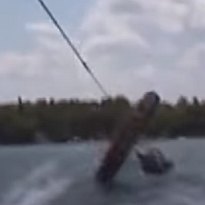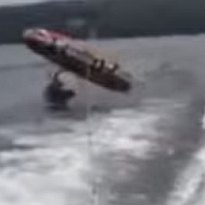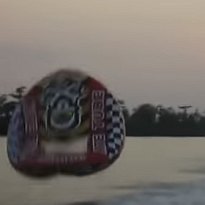The Kite Tube Craze
Enticing, Exciting, Short-Lived :-|
Flying along in a kite tube just meters over the water seemed like a lot of fun back in 2006. Water-sport enthusiasts just loved the idea of being towed behind a power boat at speed—and having the option of getting airborne for a while!
Wow. Deep down, most of us have bird envy to a degree, wouldn't you say? Even those who hate flying in aircraft must have had a pleasant flying dream or two at some point in their lives, particularly during childhood. I know I did.
The flying tubes from Wego sold like crazy while they were available. The closest competitor was the aptly-named Manta Ray. It was the big water-sport thing of the year. Heck, the Wego Kite Tube even received the Sports Product of the Year by the Sporting Goods Manufacturers Association! Little did they know.
On this site, there's more kite-making info than you can poke a stick at. :-)
Want to know the most convenient way of using it all?
The Big MBK E-book Bundle is a collection of downloads—printable PDF files which provide step-by-step instructions for many kites large and small.
Every kite in every MBK series.
Kite Tube Statistics
Oh stop that yawn. Some stats are interesting. Here are some stats that paint a telling picture of the short-lived flying boat-tube craze.
Although there were several similar products, the most notorious was the Wego Kite Tube. It was definitely the star performer in the popular Kite Tubing Fails Compilation video! These details relate to that product:
 Wego Kite Tube at 30 feet
Wego Kite Tube at 30 feet- When was it released? 2005.
- How fast did it go? A 20 mph (about 35 kph) limit was the rule, for safety. Of course, that didn't stop people going faster. It would happen either deliberately, inadvertently due to poor spotting, or as a result of headwinds.
- How high did it go? 30 feet (10 meters) was the advertised capability, and video footage bears this out. In fact, it seems it went even higher than that under the right errm perhaps the wrong conditions!
- How big were they? The circular product was about 10 feet (3 meters) in diameter.
- Did it have controls? Well sort of. Two handles attached to the floor were meant to help you get the thing in the air once the boat was up to speed. Crude!
- How long was it popular? Not much more than one year. After the products were released, the sport went into decline after the bad news started trickling in. People weren't keen on getting a broken back or a punctured lung like some poor souls—let alone leaving the planet altogether. The sport was definitely over after the Wego product was recalled and made illegal in many states of the USA. The Manta Ray followed a couple of years later.
- How many injuries were recorded? By July 2006, 84 injuries had been reported. This included three deaths (!), which all occurred over a three-month period. That sure got some attention.
Hairy Video Stills
Yes, here are hairy ejections and impacts frozen in time. Most of these people got hurt although not seriously. For some of these guys (and girls) it was like getting slapped against a rock face.
(Apologies for the poor quality of these images; they were taken on phones in bad weather, then cropped from a video frame! But it's good enough for a laugh, I say.)
 Mate, flapping's not going to help!
Mate, flapping's not going to help! Still trying to hang on...
Still trying to hang on... Love doin' hand-stands on my Manta.
Love doin' hand-stands on my Manta. Ooh me shoulder...
Ooh me shoulder... Dude, you landed it!
Dude, you landed it! Flick-roll and inverted touchdown. Cool.
Flick-roll and inverted touchdown. Cool. Bombs away! The bigger they are...
Bombs away! The bigger they are... Another inverted nose-dive. Ouch, need a neck brace.
Another inverted nose-dive. Ouch, need a neck brace. Pull up! Pull up! *smack* (side view)
Pull up! Pull up! *smack* (side view) Inverted diving lesson #3 - let's try a faster one...
Inverted diving lesson #3 - let's try a faster one... Hey, this is better than the 10-meter board at the pool!
Hey, this is better than the 10-meter board at the pool! Arnie: Arrrgh ... must ... hang ... on ...
Arnie: Arrrgh ... must ... hang ... on ...
Thoughts as a Kite Designer
While I am not highly qualified in aeronautical engineering, I have made and flown the odd homemade kite. OK, maybe a couple of hundred by now. :-) With all that making, flying, testing, and tweaking of many types of kites over the years, some knowledge has been picked up. So seeing video footage of these flying boat-tubes in action immediately made me regard these objects as kites. How good were they as kites? Mmmmmmm.
Initial impressions were that kite tubes
- were heavy (even without someone on board!)
- were unstable in yaw and pitch (prone to skidding around sideways or suddenly dropping the nose end)
- had a very narrow wind range (so much effort to get clear of the water, then so close to over-speeding)
Great! Kite clubs would have never been interested, that's for sure. ;-)
I took the time to check out a few videos, particularly that very popular compilation. :-) The kite-tube design certainly looked stable enough under controlled conditions. However, problems showed up where there was sudden changes in line tension, causing pitch-overs, or simply too much line tension, which forced the "kite" into directional instability.
It was easy to see how sudden increases in wind speed—gusts in other words—would cause problems. These events would be difficult to pick from down in the boat. A high-mounted anemometer would certain help, if someone was monitoring it closely.
In the videos I even saw evidence of people shifting their weight sideways in desperate attempts to correct (!) problems. Of course, if the timing wasn't good, this was more likely to make things worse! It would be a bit like over-correcting after hanging the back out in a sports car.
Riding the flying boat-tube was probably safe enough with skilled operators in good weather but otherwise was a disaster waiting to happen—IMHO.
The company that recalled the kites I mean flying boat-tubes ;-) must have had lawyers breathing down their necks when they wrote the recall notice. I mean, did they really have "no idea" why there were problems? Yes, they used those exact words. Anyway, it's all over now.
In Conclusion
So the kite-tube product was a very poor kite. But it would have been an excellent water-sport product if they had managed to make it much, much safer to operate in windy conditions. Pressure-sensitive vents or something? Better aerodynamics? There would have to be a way.
As mentioned earlier, there's more kite making on this site than you can poke a stick at. :-)
Want to know the most convenient way of using it all?
The Big MBK E-book Bundle is a collection of downloads—printable PDF files that provide step-by-step instructions for many kites large and small.
That's every kite in every MBK series.
